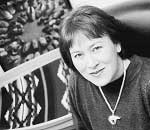 |
|
Lori Alvord, MD |
|
Medical School Recollection: Living, Breathing Surgery
By Joyce Thomas
Photo courtesy of: Dartmouth Medical School
When she started at Stanford in 1981, Lori Alvord, MD never expected to become a surgeon -- at that time a pursuit highly atypical for a woman, especially a Navajo woman. Nevertheless, she fell in love with surgery and went on to become the first Navajo woman surgeon.
Looking back, she says, Stanford's supportive atmosphere for female surgical trainees helped make her dream a reality.
Alvord, medical school class of 1985 and residency class of 1991, recalls in particular a surgery rotation at Santa Clara Valley Medical Center with Luther Cobb, MD. "He took me under his wing," she says.
With a huge number of patients and a team of physicians who worked as a community of surgeons, the SCVMC rotation in 1984 provided a rich educational environment. "We lived, ate, breathed surgery; it was very enjoyable, animated, a great learning laboratory," recalls Alvord.
At Stanford, says Alvord, both James Mark, MD, and Harry Oberhelman, MD, stood as pillars of surgery and were very well-liked. "Oberhelman handled really difficult surgical cases but was always pleasant," she says. "He always had a smile."
The general surgery and cardiac surgery programs were spectacular, guided by medical stars such as transplant pioneer Norman Shumway, MD, she says.
She fondly recalls cardiac surgeon Craig Miller, MD. "He was awesome and he had a wonderful sense of humor."
In addition to working at Stanford Hospital, Alvord was a patient there during her second year of residency when she experienced high fevers and serious chest pain. The diagnosis was empyema, a pneumonia that breaks through the lining of the lung and had a 30 percent mortality at that time. "Thankfully, I didn't know that."
She says she realized then that the hospital where she was working and learning did an outstanding job providing care.
"Also I was fortunate in training at the time that John Collins, MD, was chair of surgery," she says. "He encouraged and promoted women in surgery, which was against the grain of the national perception among surgeons."
At an informal ceremony near the close of her Stanford training in 1991 Alvord gave Collins a Navajo rug in appreciation. "Collins, who was generally all business, gave me a copy of a book called 'The Natural Superiority of Women,' " she says.
One last recollection goes back to spring 1985 and Match Day, when graduating medical students find out where they will go for their postgraduate training.
Alvord, who was homesick for New Mexico and hoping to match with the University of New Mexico, dreamed she had instead matched at Stanford.
"In my dream, I started to cry. When I woke I wondered, 'What's really going to happen?' Well, obviously, I did match with Stanford," she says. "Maybe the dream was to prepare me. Maybe destiny was making the decision for me, the right one. I discovered that UNM did not have many women residents and New Mexico would have been a hostile, uninviting place for me.
"Ultimately, I got used to the idea of a longer time at Stanford, which turned out to be the best place for me," says Alvord.
Alvord, MD, now associate dean of student affairs and multicultural affairs and assistant professor of surgery at Dartmouth Medical School, describes her journey as a surgeon in The Scalpel and the Silver Bear, Bantam Books, 1999.
Comments? Contact Stanford Medicine at

